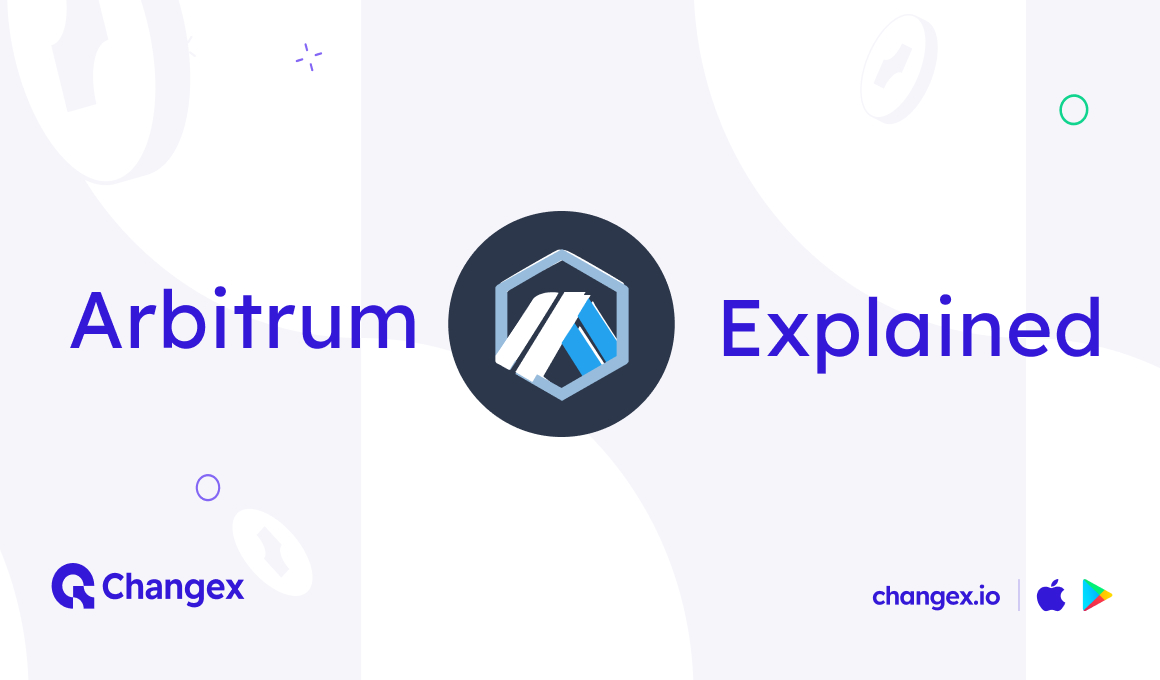The Changex wallet now supports the Arbitrum network, paving the way to a smoother and more efficient user DeFi experience in the app. But what is the Arbitrum network anyway and why is this integration important?
Let’s dive deep.
Arbitrum network explained
Arbitrum is a Layer 2 scaling solution for the Ethereum network. It is designed to address some of the scalability issues that have been plaguing the Ethereum blockchain for some time. If these words make no sense, fret not – we’ll explain.
Scaling explained (briefly)
Blockchains are limited in the number of transactions they can handle per second, which can lead to network congestion and higher fees during peak usage periods.
Scaling refers to the process of increasing this transaction processing capacity of the Ethereum blockchain network. This can be achieved through the implementation of various mechanisms such as sharding, rollups, or sidechains. Arbitrum is one such solution – a Layer 2 solution.

What is a Layer 2 solution?
A Layer 2 scaling solution is an off-chain technology that operates alongside the main blockchain to increase its transaction throughput and processing speed.
A Layer 2 (or L2) solution unburdens the main chain by taking transactions off its back, verifying them, and only using the main blockchain to conduct the final settlement.
The Arbitrum network works in this way exactly. It creates a sidechain that runs in parallel to the Ethereum mainnet, which allows for faster and cheaper transactions.
The mechanism used to achieve this is called “optimistic rollups”.
Optimistic rollups – what are those?
Put simply, optimistic rollups are one proposed solution to the Ethereum scaling problem, as they can significantly increase its throughput and reduce fees.
Optimistic rollups work by bundling transactions together in batches and committing them to the blockchain as one single transaction instead.
The point is to offload the majority of the transaction processing and validation work off the chain, while maintaining its security and trust.
In Arbitrum, transactions are first processed off-chain in a virtual machine called the Arbitrum Sequencer. The Sequencer plays a crucial role in the whole process by receiving batches of transactions from users and validators. It then verifies the validity of each transaction and creates a proof of validity for each batch – a sort of receipt. This receipt is then published to the Ethereum mainnet, where it can be verified by anyone who wants to access the data. This reduces the gas fees and increases the transaction throughput.
Benefits
There are several benefits to using the Arbitrum network.
First and foremost, it is much faster as opposed to using the Ethereum network directly, and transactions on the network can be confirmed in a matter of seconds, compared to much longer times on Ethereum.
Moreover, the gas fees on the network are significantly lower than those on the Ethereum network. This makes it a more cost-effective solution for users who want to make frequent transactions without having to pay the infamous Ethereum gas fees (at one point Ethereum gas cost nearly $200 for one single transaction. It hurts just thinking about it.)
Finally, but definitely deserving of a higher ranking on the list, the Arbitrum network is fully compatible with Ethereum, which means that users can seamlessly move their assets between the two networks without any issues.
Some of the problems that Arbitrum pledges to solve:
- Scalability: The Ethereum network has a limited capacity, which can lead to slow transaction processing times and high fees during times of high demand. Arbitrum solves this problem by processing transactions off-chain and then periodically settling them on the Ethereum network. This allows for faster and more cost-efficient transactions.
- Security: Arbitrum is built on top of Ethereum, so it benefits from the security and decentralization of the Ethereum network. Additionally, it uses fraud proofs to ensure that any invalid transactions are detected and rejected. Because Arbitrum verifies transactions off-chain in a sidechain, and then periodically verifies on-chain, if someone submits an invalid transaction to the sidechain, it could potentially go undetected until it is submitted to the main Ethereum blockchain. This is where fraud proofs come in: they “demonstrate” to the main chain that a transaction on the sidechain is invalid or fraudulent. When submitted to the Ethereum blockchain, fraud proofs are verified by smart contracts. If a fraud proof is verified, the corresponding transaction on the sidechain is considered invalid, and any funds associated with that transaction can be recovered. This adds an extra layer of security.
- Compatibility: Developers can use the same tools and programming languages they are familiar with on Ethereum to build on Arbitrum, which makes it easy to adopt and integrate into existing Ethereum-based projects.
- Decentralization: Arbitrum is designed to be decentralized, which means that no single entity has control over the network. This ensures that the network is resilient to attacks and censorship, and that users can trust the system to operate fairly and securely – something that seriously aligns with our philosophy.
Now that you’re aware of the problems Arbitrum solves, here’s why Changex integrating the network is important.
With this integration, Changex users gain an advantage on multiple fronts, including:
- Fast and inexpensive transactions: DeFi wallets that integrate Arbitrum can offer faster and more cost-efficient transactions.
- Improved user experience: Faster and cheaper transactions, naturally lead to a smooth, seamless experience when using DeFi applications. This branches out to many benefits of its own.
- Access to more DeFi applications: As more Dapps are built on Arbitrum, a wider range of services will also be available in Changex.
- Enhanced security: Arbitrum uses fraud proofs to ensure that any invalid transactions are detected and rejected. This adds an extra layer of security to DeFi transactions.
- Interoperability: Arbitrum is compatible with other Layer 2 scaling solutions, which means that users of DeFi wallets that integrate the network can move their assets seamlessly between different Layer 2 networks without having to settle transactions on the Ethereum network directly.
Overall, integrating Arbitrum gives us the ability to offer a faster, cheaper, and more secure experience, while also enabling access to a variety of DeFi applications and services in the future.
We hope you’ve found this explainer useful. If so, feel free to share 💖
Thank you for reading,
The Changex team






6 comments
Love your blog
Arbitrum Chain is the next step to the biggest and best crypto Wallet and product out there! Great to hear!
I love to hear this news that changex integrated to arbitrum network
THis is some good news. changex is making some big steps.
Nice work!!
I’m new to using changex wallet, and I like it the available coins are quite a lot and complete the feature that I like the most, there you can stake coins with quite good APY income